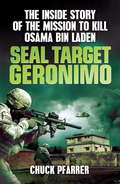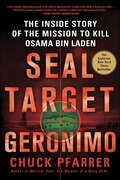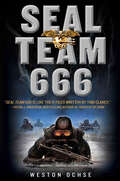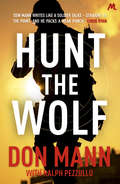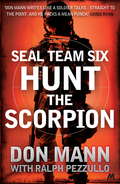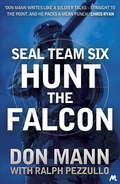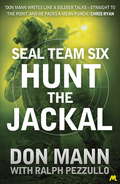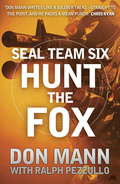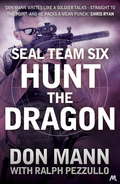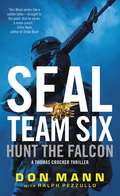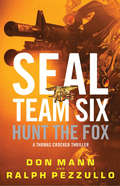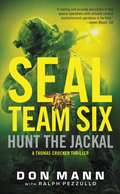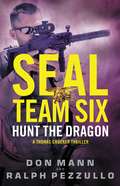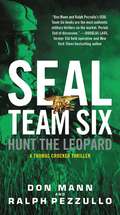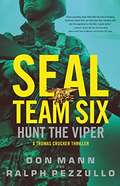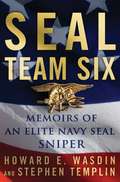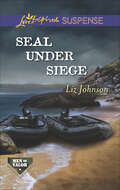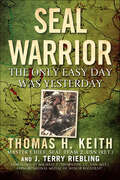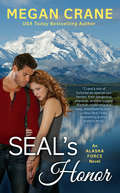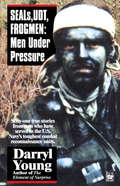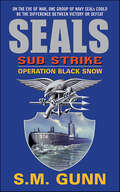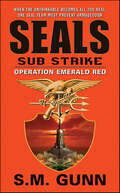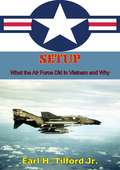- Table View
- List View
SEAL Target Geronimo: The Inside Story of the Mission to Kill Osama Bin Laden
by Chuck PfarrerOn May 2, 2011, at 1:03 a.m. in Pakistan, a satellite uplink was sent from the town of Abbottabad crackling into the situation room of the White House in Washington, D.C.: 'Geronimo, Echo, KIA'. These words, spoken by a Navy SEAL, put paid to Osama bin Laden's three-decade-long career of terror. This is the story of Bin Laden's relentless hunters and how they took down the terrorist mastermind, told by Chuck Pfarrer, a former assault element commander of SEAL Team Six. After talking to members of the SEAL team involved in the raid, Pfarrer shares never-before-revealed details of the historic raid and the men who planned and conducted it in an exclusive boots-on-the-ground account of what happened during each minute of the mission - both inside the building and outside. Pfarrer takes readers inside the operation as the SEALs flew over the wall of Bin Laden's shabby compound and then penetrated deeper and deeper into the terrorist's lair, telling us just what it looked, sounded, and smelled like in that sweltering Pakistani suburb. He takes us to the exact spot where the al-Qaeda leader was cowering when the bullet entered his head. SEAL Target Geronimo is an explosive story of unparalleled valour, clockwork military precision, and deadly accuracy carried out by one of the most elite fighting forces in the world - the U.S. Navy's SEAL Team Six.
SEAL Target Geronimo: The Inside Story of the Mission to Kill Osama bin Laden
by Chuck PfarrerThe controversial New York Times bestseller that tells the "engrossing account of the military operation that resulted in the death of Osama bin Laden." —Kirkus Reviews (starred)On May 2, 2011, at 1:03 a.m. a satellite uplink was sent from Pakistan crackling into the situation room of the White House: "Geronimo, Echo, KIA." These words, spoken by a Navy SEAL, ended Osama bin Laden's reign of terror. SEAL Target Geronimo is the story of Neptune's Spear from the men who were there. After talking to members of the SEAL team involved in the raid, Pfarrer shares never-before-revealed details in an exclusive account of what happened as he takes readers inside the walls of Bin Laden's compound penetrating deep into the terrorist's lair to reach the exact spot where the Al Qaeda leader was cowering when the bullet entered his head. SEAL Target Geronimo is an explosive story of unparalleled valor and clockwork military precision carried out by the most elite fighting force in the world—the U.S. Navy's SEAL Team Six.
SEAL Team 666: A Novel (Seal Team 666 Ser. #1)
by Weston OchseWINNER OF THE "FICTION - ADVENTURE OR DRAMA" AWARD FROM THE NEW MEXICO-ARIZONA BOOK AWARDS Weston Ochse's SEAL Team 666 follows Cadet Jack Walker. Halfway through SEAL training, he's still green but showing incredible promise when he's whisked away to join four SEALs—and their dog—for a special ops mission. Walker soon finds himself in a whirlwind of otherworldly creatures and events as he finds out the true nature of this "special ops" team: SEAL Team 666. Battling demons, possessed humans, mass-murdering cults, and evil in its most dark and primeval form, SEAL Team 666 has their work cut out for them. And it's not long before they realize that the threat isn't just directed against the U.S.—an ancient and deadly cult has bigger plans, and Walker is at the center of a supernatural conflict with the entire world at stake.
SEAL Team Six Book 1: Hunt the Wolf
by Ralph Pezzullo Don MannMulholland Books presents... HUNT THE WOLFNavy SEAL commander Thomas Crocker doesn't do downtime. In the aftermath of a gruelling mission, he and his team decide to wind down... by climbing K2.But the world is a dangerous place wherever you go. On the mountain slopes Crocker meets a man with an appalling story - all over Europe, young girls are going missing. The authorities suspect a terrorist group is involved, but cannot prove it.Crocker and his men are sent to investigate. Their aim: to track down the ruthless men behind the kidnappings before their victims pay the ultimate price. But as they follow the trail from Scandinavia to the Middle East, they find themselves facing a web of terrorist cells with more terrifying ambitions than they could have imagined.
SEAL Team Six Book 2: Hunt the Scorpion
by Ralph Pezzullo Don MannAn action-packed military thriller for fans of Chris Ryan and Andy McNab. A series of attacks all over the globe are linked by a single, deadly intent: someone is gathering everything they need to make a dirty bomb. The terrorists behind it are shadows; their targets unknown. Navy SEAL Commander Thomas Crocker and his elite team need answers. They need to go to the source: to track down the material the terrorists are searching for, and stop it falling into the wrong hands. The hunt takes them through the Yemen, to a hijacked boat off the Somali coast, and into the chaos of post-revolutionary Libya...where their mission becomes terrifyingly personal.Don Mann was on active duty with SEAL team six until 1998. SEAL Team Six: Hunt the Scorpion combines his real-life insight with pulse-pounding action and non-stop thrills.
SEAL Team Six Book 3: Hunt the Falcon
by Ralph Pezzullo Don MannAn action-packed military thriller for fans of Chris Ryan and Andy McNab. Thomas Crocker and SEAL Team Six are back for another fast-paced adventure from former SEAL commando Don Mann. The team's number one enemy, Iranian terrorist Farhed Alizadeh, codename 'the Falcon', resurfaces as the mastermind behind a series of attacks on American diplomats across the globe. Crocker and his men are ordered to bring him to justice, and their hunt leads from Bangkok to Caracas, and finally to Iran itself, when the team go in 'full black' to take down their mark. Expect nonstop thrills from the first page to the very last full stop.
SEAL Team Six Book 4: Hunt the Jackal
by Ralph Pezzullo Don MannAn action-packed military thriller for fans of Chris Ryan and Andy McNab. When a Senator's wife and teenage daughter are kidnapped, Crocker and SEAL Team Six are sent to the cities of Mexico and the jungles of South and Central America, hot on the trail of Mexican drug lords and a Colombian narco-terrorist who is known as the Jackal. A self-styled narcotics kingpin who has undergone plastic surgery to disguise his looks, the Jackal is as ruthless as he is colourful, and must be stopped. With drugs, gangs, double-crosses, and plenty of bullets, HUNT THE JACKAL will throw the team into a new environment and an unexplored corner of the world, allowing Don Mann to display his extensive knowledge about how elite warriors can adapt and fight in any situation.
SEAL Team Six Book 5: Hunt the Fox
by Ralph Pezzullo Don MannAn action-packed military thriller for fans of Chris Ryan and Andy McNab.On his way to a meeting with a CIA source in Istanbul, Captain Thomas Crocker notices he's being tailed. He suspects the men tracking his movements are members of Syria's intelligence agency, the Mulhabarat - their presence a sign of the region's increasing volatility.Syria's government is unravelling, with the alliances between rebel groups increasingly complex, and ISIS dangerously in the mix. Farid al-Kazaz, aka the Fox, leads the most threatening of the ISIS factions. He has vowed revenge for his brother's death, planning an attack that would wreak havoc across not just Syria, but the entire Middle East.Against almost impossible odds, it's up to Crocker and the rest of SEAL Team Six to stop a ruthless killer and keep an explosive plot from detonating. Once again, the fate of millions rests on the shoulders of these fearless men.
SEAL Team Six Book 6: Hunt the Dragon
by Ralph Pezzullo Don MannAn action-packed military thriller for fans of Chris Ryan and Andy McNab. Navy SEALs Crocker and Mancini are on a training exercise in Las Vegas when a moment of relaxation is interrupted by a violent altercation between hotel security and three businessmen claiming to be Chinese diplomats. They attempt to stop the fleeing businessmen, but soon realise that they may not be who they claim to be. That same night Las Vegas goes dark - someone has hacked into the Nevada Power Company system and shut down the entire city. As chaos reigns the businessmen make their escape. When Crocker and the rest of SEAL Team Six attempt to track them down, they find themselves drawn into a North Korean plot that combines cyber warfare and the theft of black market nuclear weapons. As darkness reigns, the squad is the last hope of preventing a conspiracy that could have catastrophic international consequences.
SEAL Team Six: A Thomas Crocker Thriller (A Thomas Crocker Thriller #3)
by Ralph Pezzullo Don MannSEAL Team Six and Thomas Crocker are back hunting their most elusive adversary yet: The Falcon. SEAL Team Six operative Thomas Crocker is no stranger to missions of the highest national importance and the gravest danger. But this time, the mission hits close to home. The Iranian terrorist he and his squad are chasing is the same man who kidnapped his wife months before-the Falcon, who has been stealing Libyan nuclear material and is laying plans for a devastating attack against America. The hunt takes the team from Bangkok to Caracas in hot pursuit of the Falcon and his forces.Meanwhile, Corcker's estranged father--a former firefighter and hell-raiser who was kicked out of the Nacy as a young seaman--reappears, forcing Crocker to acknowledge his life outside the shadows of SEAL operations. Doing so isn't easy when duty calls over three hundred days of the year, and when it's this essential to take an enemy down.Hunt the Falcon ups the ante for Crocker and the rest of SEAL Team Six as never before. The bullets fly, the action is relentless, and by the end Crocker and his crew will be put to the ultimate test: surviving captivity under the most depraved of men and taking the fight to the Falcon's doorstep, deep in the heart of Iran.
SEAL Team Six: Hunt The Fox (A Thomas Crocker Thriller #5)
by Ralph Pezzullo Don MannIn war-torn Syria, the heroes of the SEAL Team Six series defuse an ISIS warlord's explosive plot.After a meeting with a CIA source in Istanbul ends in tragedy, SEAL Team Six Chief Warrant Officer Thomas Crocker vows revenge. He suspects the men who attacked him and his contact are involved in the the latest and most harrowing scheme SEAL Team Six is charged with preventing, in a region that grows more volatile by the day.Syria's government is unraveling, with the alliances among rebel groups increasingly complex and ISIS dangerously in the mix. Farid al-Kazaz, aka the Fox, leads the most threatening of the ISIS factions. The Fox believes Syrian President Bashar al-Assad ordered the murder of the Fox's brother and is planning a sarin gas attack that would wreak havoc across not just Syria, but the entire Middle East. It's up to Crocker and the rest of SEAL Team Six to stop a ruthless killer and keep an explosive plan from detonating.The SEAL Team Six series has been hailed by special forces veterans and members of the intelligence community as a fascinating, behind-closed-doors look at the real-life heroism of our country's bravest soldiers. Now, Mann and Pezzullo use their experience and insight to tell the story of a terrifying plot ripped straight from the headlines.
SEAL Team Six: Hunt The Jackal (A Thomas Crocker Thriller #4)
by Ralph Pezzullo Don MannReal-life SEAL Don Mann brings all of his insight and experience to the next installment of the SEAL Team Six series. When a senator's wife and teenage daughter are kidnapped, Thomas Crocker and SEAL Team Six are sent to Mexico's lawless countryside, where federal agents protect violent narcotics kingpins instead of hunting them down. The two women have been taken by the Jackal, a drug lord drunk on power and influence. He also happens to be a self-styled modern Che Guevara, having undergone plastic surgery to disguise his looks and justifying his brutal methods and Machiavellian drug empire with the politics of social revolution. The Jackal is as ruthless as he is colorful, and he must be stopped. Crocker and the SEALs have only a matter of hours to track down and rescue the two innocent civilians held at the mercy of this madman. With dirty cops, dangerous cartels, lavish tropical estates, double-crosses and plenty of bullets, Hunt the Jackal places the team in perilous new territory and demonstrates how elite warriors can adapt to and fight in any situation. With insight into sensitive intelligence so top secret it can only be hinted at in fiction, Mann and Pezzullo have, over several books, used their extensive knowledge to offer a look behind the curtain at the life-or-death black-ops missions executed by a select handful of the bravest soldiers. Now, with Hunt the Jackal, the authors focus their lens even closer to home upon the dangers that lurk just across the U. S. border in a pulse-pounding thriller that ups the ante even as it sheds light on the real-life heroes and villains of the fight against narcoterrorism.
SEAL Team Six: Hunt the Dragon (A Thomas Crocker Thriller #6)
by Don MannThe North Korean government is days away from realizing its nuclear ambitions and only the heroes of SEAL Team Six can stop it.Chief Warrant Officer Thomas Crocker of SEAL Team Six's Black Cell is in Las Vegas after conducting a training exercise in the desert with new members of the team. Lounging by the pool at Caesar's Palace, he witnesses an argument between hotel security guards and three Asian men in corporate attire that quickly turns physical. Giving chase, he soon corners the businessmen, who claim to be Chinese diplomats under the protection of diplomatic immunity. Except the men don't respond when the head of hotel security--Crocker's old friend--addresses them in Mandarin. That night, someone hacks into the Nevada Power Company system, and Las Vegas goes completely dark. The businessmen set their hotel suite on fire and escape amidst the chaos. At the same time, James Dawkins, a brilliant scientist with top-secret clearance, disappears from a conference in Geneva and wakes to find himself in a North Korean bunker with instructions to solve an engineering problem that will enable North Korea to launch nuclear attacks on its enemies worldwide. Chasing a trail of evidence that takes them from U.S. soil to international waters to China and North Korea, Crocker and the rest of SEAL Team Six find themselves in the middle of an international plot with dangerous geopolitical ramifications. The North Korean government will stop at nothing to realize its long-held nuclear ambitions--but it'll have to get through some of America's most highly trained warriors first.
SEAL Team Six: Hunt the Leopard (A Thomas Crocker Thriller #8)
by Ralph Pezzullo Don MannThomas Crocker's SEAL Team Six crew deploys to the Nigerian jungle to combat arms and human trafficking by Boko Haram, in Don Mann and Ralph Pezzullo's latest fiercely authentic military thriller. The charismatic Boko Haram leader Ratty Festus, also known as the Leopard, has been terrorizing drought-ridden northeastern Nigeria: raiding villages, blowing up government buildings, and kidnapping schoolgirls. When Thomas Crocker and his Black Cell team, who are in the country on a special training mission, hear about a possible arms-for-schoolgirls exchange between Boko Haram and a Russian arms dealer on the Cameroon border, they convince a Nigerian Special Forces unit to join them in trying to stop it. The operation quickly goes south, with a deadly helicopter crash and an ambush. They can't manage to save all of the girls, even with assistance from a quick-thinking group of British private-security contractors.A week later, the Leopard seizes control of a $500-million dollar Gulf Oil natural gas plant, demanding a $50-million dollar ransom and safe passage out of the compound. Crocker has just 24 hours to plan and execute a high-risk, low-probability, mission to rescue all eighty innocent hostages--including two of his own who are trapped with the civilians.
SEAL Team Six: Hunt the Viper (SEAL Team Six #7)
by Ralph Pezzullo Don MannDon Mann and Ralph Pezzullo's shockingly authentic military thriller sends Thomas Crocker and his SEAL Team Six brothers to confront a notorious ISIS general, The Viper, during the occupation of Aleppo, Syria.Despite the efforts of the Assad government and its Russian and Turkish allies, Syria is succumbing to the Islamic State. While Crocker and his SEAL Team Six comrades try to help a small Kurdish border town organize a resistance army, he finds an unexpected connection with Severine, a French epidemiologist working for Doctors Without Borders. As Severine and her colleagues establish a makeshift hospital in besieged Aleppo, Crocker counsels caution. He knows too well that their NGO status will be no protection from the Viper, a notoriously vicious ISIS general with a deeply personal hatred of the West. When the Viper's men kidnap one of Severine's American colleagues, Crocker will pull every string at his disposal to launch a rescue mission. But in a situation where the US has no official business, he'll push every boundary of how far he's willing to go--and how far his SEAL brothers in arms will follow him--to save innocent lives.
SEAL Team Six: Memoirs of an Elite Navy SEAL Sniper
by Howard E. Wasdin Stephen TemplinA book that takes you inside SEAL Team Six, the covert squad that killed Osama Bin Laden. SEAL Team Six is a secret unit tasked with counterterrorism, hostage rescue, and counterinsurgency. In this dramatic, behind-the-scenes chronicle, Howard Wasdin takes readers deep inside the world of Navy SEALS and Special Forces snipers, beginning with the grueling selection process of Basic Underwater Demolition/SEAL (BUD/S) the toughest and longest military training in the world. After graduating, Wasdin faced new challenges. First there was combat in Operation Desert Storm as a member of SEAL Team Two. Then the Green Course: the selection process to join the legendary SEAL Team Six, with a curriculum that included practiced land warfare to unarmed combat. More than learning how to pick a lock, they learned how to blow the door off its hinges. Finally as a member of SEAL Team Six he graduated from the most storied and challenging sniper program in the country: The Marine's Scout Sniper School. Eventually, of the 18 snipers in SEAL Team Six, Wasdin became the best; which meant one of the best snipers on the planet. Less than half a year after sniper school, he was fighting for his life. The mission: capture or kill Somalian warlord Mohamed Farrah Aidid. From rooftops, helicopters and alleys, Wasdin hunted Aidid and killed his men whenever possible. But everything went quickly to hell when his small band of soldiers found themselves fighting for their lives, cut off from help, and desperately trying to rescue downed comrades during a routine mission. The Battle of Mogadishu, as it became known, left 18 American soldiers dead and 73 wounded. Howard Wasdin had both of his legs nearly blown off while engaging the enemy. His dramatic combat tales combined with inside details of becoming one of the world's deadliest snipers make this one of the most explosive military memoirs in years.
SEAL Under Siege (Men of Valor)
by Liz JohnsonA Navy SEAL will do anything to protect a woman targeted by terrorists in this suspenseful romance of danger and faith.When Staci Hayes is rescued from a Mideast prison by navy SEAL Tristan Sawyer, she thinks the ordeal is over. But back in San Diego, a new threat arises. Staci has information that could prevent an attack on U.S. soil, and the terrorist will stop at nothing to silence her. Tristan insists on being her bodyguard, but his constant presence makes her long for things beyond her reach. Protecting Staci is the second chance Tristan needs to put the past behind him. Yet with a spy on the naval base, anyone could be a threat. Now it will take all of his faith and courage to offer her safety—and love.
SEAL Warrior: Death In The Dark: Vietnam 1968--1972
by Thomas H. Keith J. Terry RieblingSEAL Warrior is a vivid, action-packed account of Thomas H. Keith's Vietnam tour of duty--a highly decorated Navy SEAL.During the Vietnam era, many of the U.S. Navy SEALs (SEa, Air, Land commandos) never filed for a Purple Heart unless they were severely wounded. Thomas H. Keith, Master Chief, SEAL Team 2, is living proof. He carries a piece of shrapnel behind one lung, a reminder of the day he called in 40 mm mortar fire on the enemy that was trying to catch up to his crew as the crew hauled ass out of the bush. Not only did he never report it, it was never removed---it just wasn't serious enough.SEAL Warrior is the vivid, gritty, transporting memoir of a man destined for combat, a third-generation soldier for whom serving his country was not only an honor, it was tradition. While his grandfathers fought in France, and his father's position as a U.S. Navy Chief took him all around the world, Tom Keith fought his first war in the jungles of Vietnam.Fighting a guerilla war on foreign soil for the first time in American history, the SEALS found that there were no front lines; the enemy was an integral part of the entire society. This atypical form of warfare demanded that new tactics, new strategic applications of force, and a new understanding of a complex social and cultural enmity be found.SEAL Warrior goes beyond the horror and bravado of battle to offer a deeper insight into the ways in which the SEALs fought, learned, reacted, and expanded their understanding of guerilla warfare during the Vietnam War. It's also a personal, riveting account of how one young American survived, and, over time, grew to trust and revere many of those who once had been his enemy.With America again deeply involved in guerilla warfare, there is no better time to honor the unique abilities, understanding, and courage of these warriors who sacrificed it all to fight for nothing less than peace.
SEAL of Honor
by Gary WilliamsLt. Michael Patrick Murphy, commander of Navy SEAL Team 10, posthumously received the Congressional Medal of Honor for his heroic actions on 28 June 2005 during a fierce battle with Taliban fighters in the remote mountains of eastern Afghanistan. Michael was the first recipient of the nation's highest military honor as a result of U.S. involvement in Afghanistan. He was also the first naval officer to earn the medal since the Vietnam War, and the first SEAL to be honored posthumously. A young man of great character, he is the subject of Naval Special Warfare courses on leadership, and an Arleigh Burke-class guided missile destroyer, naval base, school, post office, ball park, and hospital emergency room have all been named in his honor. In his bestselling book, Marcus Luttrell, the only survivor of Operation Red Wings, called Michael "the best officer I ever knew, an iron-souled warrior of colossal, almost unbelievable courage in the face of the enemy." SEAL of Honor tells the story of Michael's life and how he came to be that man of selfless courage and honor. This biography argues that his heroic action during the deadly firefight with the Taliban revealed his true character and attempts to answer why Michael readily sacrificed his life for his comrades. SEAL of Honor is the story of a valiant young man who was recognized by his peers for his compassion and leadership, because he was guided by an extraordinary sense of duty and responsibility. Tracing Michael's journey from a seemingly ordinary life on New York's Long Island to that remote mountainside in Afghanistan, SEAL of Honor portrays how he came to the moment of extraordinary heroism that made him the most celebrated Medal of Honor recipient since WWII. Moreover, the book brings the Afghan war back to the home front, focusing on the tight-knit Murphy family and the devastating effect his death had on them as they watched the story of Operation Red Wings unfold in the news. The book attempts to answer why Michael's service to his country and his comrades was a calling faithfully answered, a duty justly upheld, and a life, while all too short, well lived.
SEAL'S Honor (An Alaska Force Novel #1)
by Megan CraneThe first in a new romantic suspense series featuring the rugged special ops unit tucked away in Alaska's Grizzly Harbor from USA Today bestselling author Megan Crane.The last thing Blue Hendricks needs six months into his uneasy reentry into civilian life is trouble in the form of his old friend's kid sister, all grown up and smack in the middle of a dangerous murder investigation. But he didn't become a SEAL to turn his back on the hard stuff, and he can't bring himself to ignore Everly's call for help--no matter how much he knows he's not fit to be around the soft, vibrant woman she's become. Not after the things he's done. Everly Campbell is desperate. When her roommate is murdered and the body vanishes, Everly fears she might be next. With no one to believe her, Everly runs to a remote Alaskan town to find a man she only vaguely remembers and his crew of ex-military brothers who could be her only hope. Blue wants to keep things all business but Everly isn't a little girl anymore and the commanding former SEAL is more temptation than she can resist.As the men on Everly's trail draw closer, Blue will do anything to protect the woman he's starting to think of as his...
SEALS, UDT, FROGMEN
by Darryl YoungSixty-one true stories from men who have served in the U.S. Navy's toughest combat and reconnaissance units.
SEALs Sub Strike: Operation Black Snow (SEALs Sub Strike #2)
by S.M. GunnJust as the ground war in Desert Storm begins, the U.S. military must destroy the most deadly weapon in Saddam Hussein's arsenal. An air strike is too risky. An infantry charge is too slow. Next move -- bring in the Navy SEALs! The place itself is meaningless -- a small island in the Persian Gulf. But on the island is a rocket full of anthrax. If it explodes, it is close enough to Kuwait to kill thousands of Kuwaitis and servicemen. If it is launched on a rocket, it is capable of reaching the U.S. military bases in Saudi Arabia. Only one group can destroy the weapon -- the Navy SEALs. Using a secret U.S. submarine, the SEALs understand how dangerous their mission will be. Even if they are able to get past Saddam's Republican Guard to their objective, the objective itself could kill them all. But with thousands of lives and the war itself hanging in the balance, they know there is no room for even the slightest mistake.
SEALs Sub Strike: Operation Emerald Red (SEALs Sub Strike #3)
by S.M. GunnThe SEALs never rest -- but neither do their enemies. Borders have been redrawn, old enemies have fallen, and new ones have arisen from the ashes to threaten civilization. While the Cold War has ended, it has left in its wake a Russia more unpredictable, more unstable, and more dangerous than ever before. Grigory Rostov, a former commander in the elite Spetznaz special forces -- turned arms dealer, knows how to procure some of the former USSR's most destructive and vulnerable weaponry. Selling these next generation Weapons of Mass Destruction to his client will almost certainly precipitate a war between the US and China, opening the door for Russia to be reclaim its place as a the sole remaining superpower, and making Rostov a millionaire in the process. The only thing that can prevent Taiwan from becoming Ground Zero in the next World War: a top secret new unit within the Navy SEALs.
SECURING THE FUTURE OF U.S. AIR TRANSPORTATION: A System in Peril
by National Research Council of the National AcademiesThe National Academies Press (NAP)--publisher for the National Academies--publishes more than 200 books a year offering the most authoritative views, definitive information, and groundbreaking recommendations on a wide range of topics in science, engineering, and health. Our books are unique in that they are authored by the nation's leading experts in every scientific field.
SETUP: What the Air Force Did in Vietnam and Why (Williams-ford Texas A&m University Military History Ser. #30)
by Earl H. Tilford Jr.American military professionals, especially the U.S. Air Force, have had a difficult time understanding their role in this nation's defeat in Vietnam. Dr. Tilford provides a critical self-analysis and questions the underlying assumptions of the Air Force's strategy in Southeast Asia. He argues that we must understand what went wrong in Vietnam and why, and not manipulate the record and paint failure as victory. He explains what led to the "setup," which not only resulted in a failure for airpower but also contributed to the fall of South Vietnam, Laos, and Cambodia to Communist forces in 1975.
